The editors of the paper from 1953 to 1961

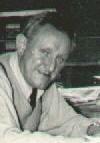
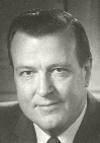
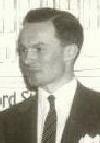
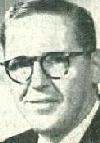
I had five editors who encouraged me and helped teach me my craft. They are pictured above, from the left, Douglas Amaron, Cuthbert Jones, George MacFarlane, Arnold Agnew, Jack Cranford.
How about a story on this summer's caterpillar invasion?
June, 1953: DOUG AMARON had hired me for the summer as a reporter, my first newsroom job. I was almost 19. The story about tent caterpillars was to be an opportunity to develop a story from scratch. Amaron and others suggested sources for information.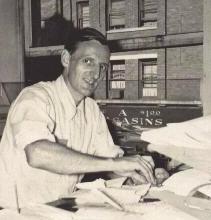 Several days later, the story appeared under my name. It was my first "byline" in the days when newspaper reporters lived for "bylines."
Soon, I was assigned to cover the centennial of the running of the first train between Sherbrooke and Portland, Maine. This was a major story spread over several communities. It took me two days to write the story. By then, the pictures had already appeared in the Record, along with a small notice that the story would appear the following day. I had missed my deadline by 24 hours. Amaron didn't lecture me but I got the hint: that it was important to finish writing a story BEFORE going home, even if that meant working through the night. My newspaper career could have ended right there, but Amaron didn't give up on me. I had six other bylines that summer. When I was back at classes at Bishop's University, he gave me a weekly university column that paid 10 cents a published inch. That went on for four years and was my chief source of pocket money while I was studying. Amaron was a former war correspondent for The Canadian Press who had been hired in 1945 by John Bassett, Jr. to be the managing editor of the Record. Amaron returned to The Canadian Press in 1954 and rose to become head of that news organization.
Several days later, the story appeared under my name. It was my first "byline" in the days when newspaper reporters lived for "bylines."
Soon, I was assigned to cover the centennial of the running of the first train between Sherbrooke and Portland, Maine. This was a major story spread over several communities. It took me two days to write the story. By then, the pictures had already appeared in the Record, along with a small notice that the story would appear the following day. I had missed my deadline by 24 hours. Amaron didn't lecture me but I got the hint: that it was important to finish writing a story BEFORE going home, even if that meant working through the night. My newspaper career could have ended right there, but Amaron didn't give up on me. I had six other bylines that summer. When I was back at classes at Bishop's University, he gave me a weekly university column that paid 10 cents a published inch. That went on for four years and was my chief source of pocket money while I was studying. Amaron was a former war correspondent for The Canadian Press who had been hired in 1945 by John Bassett, Jr. to be the managing editor of the Record. Amaron returned to The Canadian Press in 1954 and rose to become head of that news organization.
Newsroom veteran made astonishing election predictions
1954: CUTHBERT "BERT" JONES had been with the Record almost a quarter of a century when I started with the paper. He had been a reporter, editorial writer and probably just about everything else in the newsroom since finishing at Bishop's University in 1929. When Amaron left, Jones took over as editor. He relinquished that job a little while later to go back to writing editorials and to his first love -- reporting, mostly about politics. Bert's knowledge of Quebec and Eastern Townships politics was immense, and he would often spin tales to me and other young reporters about what was going on behind the scenes. In the early 1950s, Maurice Duplessis ran the province, and a lot of Bert's most fascinating tales were about him and his supporters. Before federal and provincial elections, Bert would travel around the Townships, and then come back to write his predictions. He was amazingly accurate, even down to which parties would win the 12 Eastern Townships seats. And this was in the days before pre-election polls. Perhaps his most spectacular predictions were for the 1962 federal election when he identified the Social Credit phenomenan in Quebec. That's the year Real Caouette and his party came out of nowhere to win 26 Quebec seats. Bert was still at the Record when I left in 1968.
When Amaron left, Jones took over as editor. He relinquished that job a little while later to go back to writing editorials and to his first love -- reporting, mostly about politics. Bert's knowledge of Quebec and Eastern Townships politics was immense, and he would often spin tales to me and other young reporters about what was going on behind the scenes. In the early 1950s, Maurice Duplessis ran the province, and a lot of Bert's most fascinating tales were about him and his supporters. Before federal and provincial elections, Bert would travel around the Townships, and then come back to write his predictions. He was amazingly accurate, even down to which parties would win the 12 Eastern Townships seats. And this was in the days before pre-election polls. Perhaps his most spectacular predictions were for the 1962 federal election when he identified the Social Credit phenomenan in Quebec. That's the year Real Caouette and his party came out of nowhere to win 26 Quebec seats. Bert was still at the Record when I left in 1968.
A touch of 'Pink Tely' journalism comes to Sherbrooke
1955: GEORGE MacFARLANE was the first of three up-and-coming Toronto Telegram editors sent by John Bassett, Jr. to run the Record editorial department.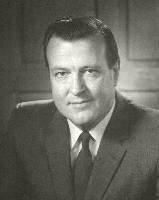 George brought to the Record a whiff of the brash and brassy style that had become the trademark of the "Pink Tely," so-called because its front page was printed on pink paper. There was no pink paper for the Record, but headlines and pictures became bigger, and more front-page treatement was given to local news stories. The Record got more involved in coverage of controversy, and sometimes started it. George taught me to handle the national and international news from the teletypes, and how to write headings, and how to make up newspaper pages. Then, from time to time, I was his news editor, choosing material for the front and other pages, writing heads, laying out the pages. When I found it difficult to decide what national or international stories to use out of the hundreds available every day, he encouraged me to have confidence in my judgment. Apart from the few obvious major stories, he said, news was whatever an editor decided it should be. George went back to Toronto as assistant editor of the new and short-lived Sunday Telegram when his tour at the Record was over.
George brought to the Record a whiff of the brash and brassy style that had become the trademark of the "Pink Tely," so-called because its front page was printed on pink paper. There was no pink paper for the Record, but headlines and pictures became bigger, and more front-page treatement was given to local news stories. The Record got more involved in coverage of controversy, and sometimes started it. George taught me to handle the national and international news from the teletypes, and how to write headings, and how to make up newspaper pages. Then, from time to time, I was his news editor, choosing material for the front and other pages, writing heads, laying out the pages. When I found it difficult to decide what national or international stories to use out of the hundreds available every day, he encouraged me to have confidence in my judgment. Apart from the few obvious major stories, he said, news was whatever an editor decided it should be. George went back to Toronto as assistant editor of the new and short-lived Sunday Telegram when his tour at the Record was over.
Journalistic freedom and advice to move on to bigger things
1957: ARNOLD AGNEW was the second Toronto Telegram editor that Bassett sent down to Sherbrooke for experience. His style was not quite as exuberant as George's,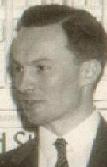 and the Record reflected his thoughtful but still vigourous, Tely-like treatment of the news. I didn't work for Arnold very long; I was doing postgraduate work in New Zealand when he arrived at the Record, and when I returned to the paper, I stayed for only about nine months before getting married and moving on to the Montreal Gazette. The move was partly Arnold's doing. He kept telling me there wasn't much more I could learn at the Record, and I should be thinking about trying to get a job on a major metropolitan daily. The Tely was often mentioned, but the less flamboyant Gazette appealed to me more. Meanwhile, Arnold gave me a great deal of journalistic freedom. I wrote editorials regularly, and expanded under his direction into the choosing, researching and writing of a lot of feature material, what would be called today "in-depth" journalism. Arnold returned to the Telegram in due course and eventually became executive editor there.
and the Record reflected his thoughtful but still vigourous, Tely-like treatment of the news. I didn't work for Arnold very long; I was doing postgraduate work in New Zealand when he arrived at the Record, and when I returned to the paper, I stayed for only about nine months before getting married and moving on to the Montreal Gazette. The move was partly Arnold's doing. He kept telling me there wasn't much more I could learn at the Record, and I should be thinking about trying to get a job on a major metropolitan daily. The Tely was often mentioned, but the less flamboyant Gazette appealed to me more. Meanwhile, Arnold gave me a great deal of journalistic freedom. I wrote editorials regularly, and expanded under his direction into the choosing, researching and writing of a lot of feature material, what would be called today "in-depth" journalism. Arnold returned to the Telegram in due course and eventually became executive editor there.
Off the street and working full-time behind a desk
1959: JOHN "JACK" CRANFORD was the third and last editor from the Telegram. He was already at the Record when I came back to Sherbrooke from the Montreal Gazette, incredibly, hired away for a bigger wage to be Jack's news editor. That was the title, but the job was actually more like a city editor's. I was in charge of reporters and correspondents and local news and sports, so for the first time, I was doing a full-time desk job instead of reporting. It was a new role for me, handling people and administration, and Jack guided me through my first steps. His experience and friendship got me over a lot of rough spots. One of our projects was to start a full-time news bureau in Cowansville, the centre of a large pocket of English-speaking residents southwest of Sherbrooke. There was potential there for increased circulation in those days. With his Telegram expertise, Jack knew about split runs -- printing one edition of the paper featuring material from the Cowansville bureau, and then another for the rest of the circulation area. It worked, and the Record eventually gained a lot of new readers. After a couple of years, Jack went back to the Telegram to become night managing editor. I took over from him as editor of the Record, which had been more or less the plan from the start. But I never would have made it without Jack's help.
Sherbrooke from the Montreal Gazette, incredibly, hired away for a bigger wage to be Jack's news editor. That was the title, but the job was actually more like a city editor's. I was in charge of reporters and correspondents and local news and sports, so for the first time, I was doing a full-time desk job instead of reporting. It was a new role for me, handling people and administration, and Jack guided me through my first steps. His experience and friendship got me over a lot of rough spots. One of our projects was to start a full-time news bureau in Cowansville, the centre of a large pocket of English-speaking residents southwest of Sherbrooke. There was potential there for increased circulation in those days. With his Telegram expertise, Jack knew about split runs -- printing one edition of the paper featuring material from the Cowansville bureau, and then another for the rest of the circulation area. It worked, and the Record eventually gained a lot of new readers. After a couple of years, Jack went back to the Telegram to become night managing editor. I took over from him as editor of the Record, which had been more or less the plan from the start. But I never would have made it without Jack's help.
(With thanks to George MacFarlane, who ran across this web page in August of 2003 when it did not contain a picture of him. Several months later, he sent me his picture from younger days to complete the "gallery." In 2003, George and his wife Barbara owned and operated a bed and breakfast inn at Cowichan Bay, B.C. They retired from the business in 2005 and moved to Nanaimo, B.C.)
Home page | History of The Record | Those Were The Days
Covering the County Fairs | Glenn Gould Comes to Town | 60th Anniversary in 1957
A First in Canada | The Strike of '62 | Learning on the Job
Montreal's Expo 67 | Trudeaumania Hits the City | Nightstaff: a poem
Memorable Headlines
Comments? Click here to E-mail author Hugh Doherty
Page created Spring 1999. Last updated Apr. 8, 2006